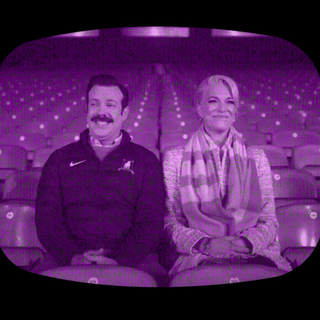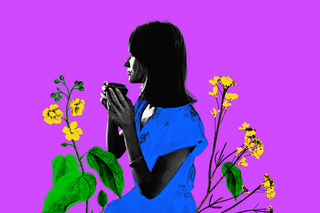
‘Slow Living’ Is an Antidote to Exhaustion Under Capitalism — But Exhausting to Achieve
Slow living — an antidote to our fast-paced world –preaches a life where ‘stop and smell the roses’ isn’t just a cliché, but a way of life.

In the technology-driven, hustle-glorifying era we live in, it can feel like life is whizzing past us faster than a rocket-powered cheetah on espresso. A world where speed limits are optional and tranquility reigns supreme, then, feels like a distant dream. Enter: “slow living,” a valiant endeavor to save the day and restore our sanity, one leisurely step at a time. Referring to a more chilled-out, intentional existence — as the antidote to our fast-paced, instant-gratification-obsessed world — slow living preaches a lifestyle where ‘stop and smell the roses’ is not just a cliché, but a way of life.
The origin of this lifestyle can be traced back to Italy’s “slow food movement” — reportedly kicked off by political activist Carlo Petrini in the 1980s, in a bid to protest the growing popularity of fast food chains like McDonald’s, and shine the spotlight on traditional food production techniques. Slow living expands upon this idea, encompassing various aspects of life, including work, leisure, and personal wellbeing. And with time, the idea gathered momentum, and its appeal drew in more followers — in particular, because of its perception as a lifestyle opposed to capitalism, consumerism, and mindless destruction of the environment. Some sources suggest that the term “slow” is, in fact, an acronym: ‘S’ stands for ‘sustainable’; ‘L’ for ‘local’; ‘O’ refers to ‘organic’; ‘W’ to ‘whole,’ or non-processed.
“I think of slow [living] as more of a mindset than anything else. It’s quality over quantity. It’s doing things with presence, being in the moment. Ultimately, it’s about doing everything as well as possible instead of as fast as possible,” says Carl Honoré, author of In Praise of Slowness: How A Worldwide Movement Is Challenging the Cult of Speed. “[I]t’s actually a profoundly revolutionary [idea] in a roadrunner culture where every moment [in] a day is a race against the clock.” In a sense, then, the slow living movement attempts to deliver from the clutches of perpetual rush-a-holism that has us running like a juiced-up squirrel on a hamster wheel.
While the movement advocates for slowing down, it doesn’t preach sloth — especially not in situations where doing so would border on ludicrous, like running into the arms of one’s lover for a passionate embrace, but in slow motion, à la Bollywood’s romantic comedies. “I think in our fast-forward culture, where the taboo against slowness runs so deep, we just assume that the only way to slow down is for everything to become incredibly slow motion, which would be absurd… Slow living [is] about doing things at the right speed. So, understanding that, sure, there are times to go fast and be busy — but there are other times when it pays to put the brakes on and slow down,” explains Honoré.
With more than 5.5 million posts tagged under #slowliving on Instagram, and over 8 million views for #slowliving on TikTok, the popularity of the movement appears to be on an upswing.
Related on The Swaddle:
Is Intuitive Eating the Answer to Tackling Diet Culture?
In fact, Google Trends observed “a stunning 4X increase in views of videos with ‘slow living’ in the title in 2020 compared to 2019,” noting: “One of the cultural side effects of the Covid19 pandemic has been the marked slowdown in the pace of our lives. We’re in a new era of ‘slow living’ and many consumers are embracing it.” Indeed, by forcing people across the globe to confront the fragility of life and reevaluate their priorities, the pandemic made the lifestyle appear more tempting.
The sudden halt in daily routines and the need to adapt to new circumstances offered people an opportunity for reflection — coinciding with a moment where they were simultaneously grappling with uncertainty about the lives of their loved ones, as traditional markers of success, such as wealth and professional achievements, suddenly began to matter a lot lesser than before. “Everything I do seems so futile right now — I’m starting to wonder what’s even the point of working so hard that we don’t even get to spend time with our family and friends, especially when we don’t know what the future is going to hold?” Prakrati, then 25, had told The Swaddle during the second wave of the pandemic in India. This pushed many to focus on their mental health and the quality of their relationships with their friends and family, over career ambitions.
Not only that, but as research has shown, living through the pandemic also ushered a marked increase in environmental awareness — inspiring many to begin consuming mindfully, reducing waste, and appreciating nature, in their bid to embrace a more eco-conscious lifestyle. This shift in their perspectives drew them towards the slow-living lifestyle whose core values — emphasizing balance, self-care, and a strong sense of community, while challenging the prevailing notion of productivity and advocating for a healthier work-life balance — resonated deeply with the transformation that their outlooks were undergoing. The slow living attitude is, after all, about setting boundaries — an approach that has a lot of takers among the millennial and Gen-Z cohorts.
“A cornerstone of being slow is saying no… relearning the lost art of saying no, of prioritizing, of taking the time to pause, reflect, and look at your life and say, ‘What is really important?’ Then focus your time and attention on those things and let everything else go,” explains Honoré.
In a sense, then, the trend of slow living is driven by our frustration with a capitalist society. However, like most other wellness trends with similar motivations — like self-care, digital detoxes, and plant-based diets — not everyone may have the privilege to pursue slow living. While the allure paints a picturesque scene of tranquility and mindfulness, it’s also pertinent to acknowledge slow living often requires time, financial stability, and resources that may not be readily available to individuals from rungs of the socio-economic strata that force them to make their peace with the daily grind for survival, leaving little room for luxuries like leisurely strolls or extended periods of self-reflection. Moreover, marginalized communities often face systemic barriers that limit their access to green spaces, quality healthcare, and mental health support — all vital components of the slow living experience.
Related on The Swaddle:
Why Mindfulness During Sex Is Linked to Greater Satisfaction, More Orgasms
At the end of the day, the fact that we live in a capitalist world, makes wellness trends like slow living, capitalist trends. Why? Well, it requires a lot of capital to actually be able to live slowly — especially without making those less privileged on us pick up our slack. First, being able to pass the burden is a privilege; second, by doing so, we’re simply following the capitalist mindset, not battling it.
Having said that, “Slow living isn’t at odds with being successful or productive. Rather, it’s about living up to your own idea of success and prioritizing what’s most important to you,” explains an article, addressing a prominent misconception about slow living. But in a world where we are pushing ourselves till we burnout simply to afford shelter and sustenance, the option to choose our idea of success and set our own ambitions, is a privilege.
The philosophy is shrouded in other myths, too — like the belief that it espouses a tech-free lifestyle. It doesn’t. As Honoré notes, “[S]low living is [about] forging a more balanced, healthier, happier, and more humane relationship with our technology… knowing when to go on and use that incredible thrilling speed of technology — and then knowing when enough is enough and to stop scrolling through Instagram or stop surfing the net while watching Netflix or just simply stop being in front of a screen.”
Slow living, then, is like the pause button for our hectic existence — offering a chance to embrace the art of unhurried living and savor life’s little pleasures. So, for those longing to rid themselves of frazzled nerves, and leisurely stroll into a life, where they have the time to actually taste their food, find their socks, and maybe, even remember their own names, slow living is probably the way to go — only if one can afford to live slowly, that is.
The takeaway: yes, slow living sounds great in theory; in practice, however, trends like slow living individualize our struggle against capitalism, and in doing so, end up bowing down to the status quo and perpetuating it selfishly, instead of registering any systemic change.
Devrupa Rakshit is an Associate Editor at The Swaddle. She is a lawyer by education, a poet by accident, a painter by shaukh, and autistic by birth. You can find her on Instagram @devruparakshit.
Related


What Is the Role of a Bystander in Gender‑Based Violence?
